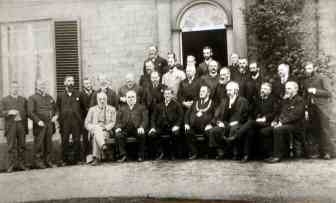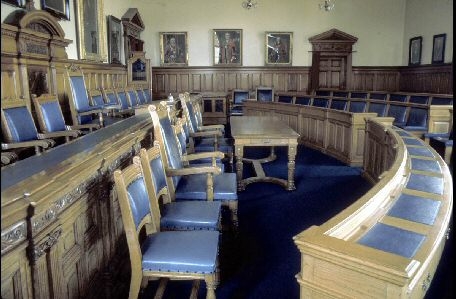19th century Morley

Morley in the early part of the 19th century was just a small village. It was administered by a man thought of as the local Squire; this was Watson Scatcherd who was also the local Magistrate. He held a fortnightly Court in the Nelson Inn sitting in the Justice’s chair with the village constable in attendance where he dealt with any culprit brought before him. This chair is now in the Mayor’s Parlour in Morley Town Hall.
Population
The Earl of Dartmouth had purchased the estate of the Manor of Morley in 1706 from the Savile family of Howley Hall. This family took no part in the management of Morley but later made some gifts of money and land to the Town.
In 1801, Morley had a population of 2000, but a later period of growth of the town in the Victorian era saw the population begin to rise. Morley suffered around 200 deaths from cholera in 1849, caused by the contamination of a well and the overall conditions of poor public health which were general around Great Britain at that time.
Public services
In 1862 the township of Morley adopted the Local Government (Public Health) Act of 1858 to form a Local Board for paving, lighting, sewerage and the provision of a piped water supply. A Local Board Office was built in Queen Street. It later became the Education Office but is now a private residence. The original building had a tower which was damaged in a gale and this was removed when the building was repaired.
Borough status
Morley petitioned Queen Victoria in 1885, requesting a Borough Charter, and became a Borough in 1886. It elected its first Town Council and appointed its first Mayor.
The township of Churwell, with a population of less than 1000, was taken into the Borough of Morley in 1891. Churwell had its own Town Hall, a small building at the junction of Victoria Street and Churwell Lane. This building is now the Churwell Community Centre.

The Councillors finally got round to giving Morley a safer supply of water in 1891, by starting to construct the Withens Clough Reservoir at Mytholmroyd in the Pennine Hills. This was to cost over £140,000.
A new Town Hall
The Aldermen and Councillors of that period decided that they needed more and better office accommodation than was available, so plans were made to build a Town Hall. It must be remembered that the population of Morley at that time almost reached 20,000 people, but it was rising every year.
A competition was held for a design of a building to cost around £15,000, but this was found to be too little in practice and the figure rose to just over £41,000 for the site, building and its furnishings. The stone was quarried from a site that is now the grassed playing fields behind Scatcherd Park. It took three years to build the Town Hall and this included a strike of some seventeen weeks. Herbert Henry Asquith, a prominent Liberal politician who was born in Morley, opened the new Town Hall on the 16th October 1895.
Successful development
During this late Victorian period, Morley had enjoyed a boom with a rising population. A lot of woollen mills were built, and the coal pits around Morley were amongst the top producers in tonnage in the country. At the end of the century, Morley Electricity Department and a Gas works were established and the town made rapid strides under its Town Council.
In 1921, Leeds City Council cast its eyes towards Morley with the idea of annexing it. This brought forth a vigorous campaign. After a long drawn out battle, Morley retained its independence, at least for another 53 years, until a Government Order in 1974 meant that Morley lost its independence as a Borough and became an unwilling part of the Leeds Metropolitan Council.
Incorporation of outlying districts
Morley itself went on the trail of expansion in 1937; Gildersome, Drighlington, East and West Ardsley Urban District Councils were incorporated into the Borough, making it one of the largest Borough Councils in England.

It was made up of 11 Wards and these were: Gildersome, Drighlington, East and West Ardsley, Churwell, North. Central, Dartmouth, Birks, Denshaw and Tingley. An Alderman and 3 Councillors represented each ward. Councillors were elected for a 3-year term and Aldermen for a 6-year term. The citizens of the Town elected Councillors, whereas the Councillors themselves elected the Aldermen.

This enlarged Council meant that the meeting Chamber had to be remodelled. This was done using English oak to match the existing furniture in The Town Hall. Only one room in the building has mahogany furniture and this is the Mayor’s Parlour.
Takeover by Leeds
A campaign was organised by Morley Council in 1971 against the governmental wish for it to become a part of Leeds. Many felt the town would not receive the service that it was entitled to and this was subsequently borne out in a plebiscite organised in October 1971. With a 42% turnout. 13,528 (98.5%) were against a Leeds take-over; 212 (1.5%) were for it. Despite this overwhelming wish, Morley still became a part of Leeds Metropolitan Council in May 1974. Six Councillors represent Morley on Leeds Council.
The battle for a new Town Council
In 1987 a 3000-signature petition was set up to campaign for a Parish Council in Morley. Leeds Council ignored this. The Ombudsman upheld a complaint about their lack of action, but Leeds Council ignored this also. However, the Local Government & Rating Act in 1997 removed the Leeds Authority’s veto and power to ignore any request. So, in 1998 another campaign to set up a Morley Town Council was again submitted to Leeds Metropolitan Council. This time Morley was able to go ahead with plans for a Town Council, since the veto was no longer possible, and the new Council was duly set up on 1st April 2000. At the elections in May, 24 Councillors were elected in the following wards: Central, Birks, Teale, Scatcherd, Topcliffe and Churwell. Gildersome and Drighlington were not included and now they have Parish Council designation with their own Councils.
The present Town Council
Morley Town Council is funded by a precept addition to the Rate payable to Leeds Council, which produces approximately £160,000 per year. A Mayor of Morley is again elected and takes part in various activities in the Town. Councillors receive no payment or expenses for their work for the Town and are elected for a 4-year term. The Town Council has been awarded Charter Status and can now make application to Leeds City Council for responsibility for certain work within Morley. This application will take place in the near future.
Contact
For further information concerning Morley Town Council, contact
The Town Clerk, Morley Town Hall, Queen Street, Morley.
Tel. No 0113 2474370.



You must be logged in to post a comment.